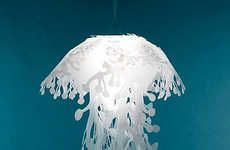
The Plexiglass Lamp Has a Hidden Bulb to Create the Perfect Mood
Rose Nazarali — January 9, 2010 — Art & Design
References: industrialdesignserved & hometone.org
The Plexiglass Lamp is meant to create the perfect starry night right in your living room. The mood setting design uses an energy-saving bulb that hides in the base of the light bulb. The light source is shot through the plexiglass rods to create the perfect setting for a romantic night in.
Even when unlit, the Plexiglass Lamp looks like a piece of modern art. Check it out in the gallery above!
Implications - Consumers are trying to conserve energy costs due to the recent economic downturn. Low-energy products also satiate consumer desire to reduce their carbon footprints upon the planet, a pattern that's proliferated on a societal scale. Corporations looking to influence consumer purchases may find it advantageous to engineer their products to utilize as minimal energy as possible.
Even when unlit, the Plexiglass Lamp looks like a piece of modern art. Check it out in the gallery above!
Implications - Consumers are trying to conserve energy costs due to the recent economic downturn. Low-energy products also satiate consumer desire to reduce their carbon footprints upon the planet, a pattern that's proliferated on a societal scale. Corporations looking to influence consumer purchases may find it advantageous to engineer their products to utilize as minimal energy as possible.
Trend Themes
1. Energy-saving Lighting - Creating low-energy lighting products that can still meet customers' mood-setting needs is an area of disruptive innovation.
2. Mood-setting Design - Designing products with the specific goal of setting a desired mood (in this case, a romantic setting) is a trend in consumer product design.
3. Functional Art - Creating functional products (in this case, a lamp) that also have an aesthetic appeal even when unlit is an area of disruptive innovation.
Industry Implications
1. Lighting - Creating energy-saving lighting products can be a disruptive innovation opportunity for the lighting industry.
2. Home Decor - Designing products that serve both a functional purpose and have an aesthetic appeal can be a disruptive innovation opportunity for the home decor industry.
3. Hospitality - Incorporating mood-setting design into hospitality environments (such as hotels or restaurants) can be a disruptive innovation opportunity for the hospitality industry.
1.5
Score
Popularity
Activity
Freshness























